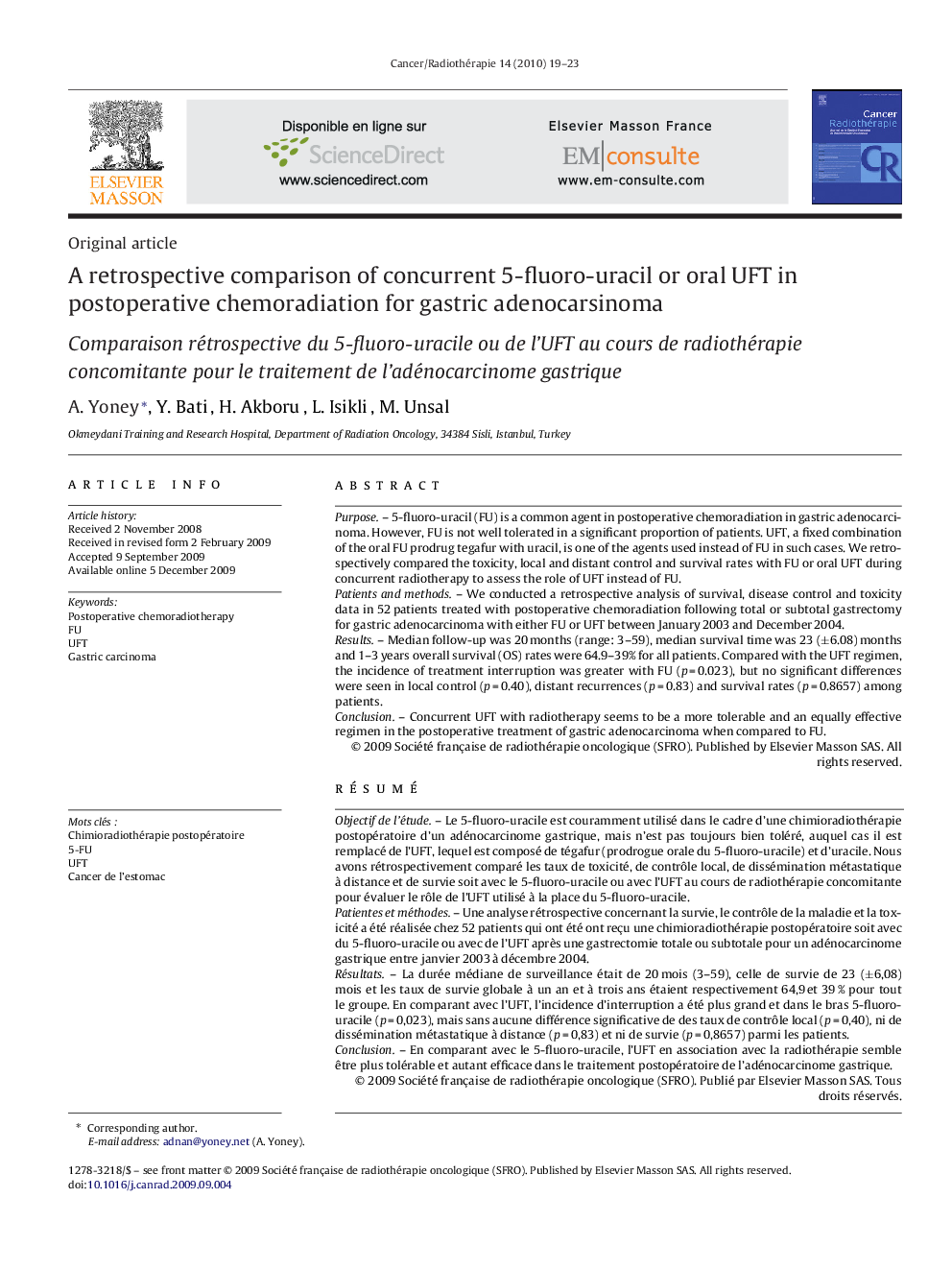| Article ID | Journal | Published Year | Pages | File Type |
|---|---|---|---|---|
| 2118451 | Cancer/Radiothérapie | 2010 | 5 Pages |
Purpose5-fluoro-uracil (FU) is a common agent in postoperative chemoradiation in gastric adenocarcinoma. However, FU is not well tolerated in a significant proportion of patients. UFT, a fixed combination of the oral FU prodrug tegafur with uracil, is one of the agents used instead of FU in such cases. We retrospectively compared the toxicity, local and distant control and survival rates with FU or oral UFT during concurrent radiotherapy to assess the role of UFT instead of FU.Patients and methodsWe conducted a retrospective analysis of survival, disease control and toxicity data in 52 patients treated with postoperative chemoradiation following total or subtotal gastrectomy for gastric adenocarcinoma with either FU or UFT between January 2003 and December 2004.ResultsMedian follow-up was 20 months (range: 3–59), median survival time was 23 (±6.08) months and 1–3 years overall survival (OS) rates were 64.9–39% for all patients. Compared with the UFT regimen, the incidence of treatment interruption was greater with FU (p = 0.023), but no significant differences were seen in local control (p = 0.40), distant recurrences (p = 0.83) and survival rates (p = 0.8657) among patients.ConclusionConcurrent UFT with radiotherapy seems to be a more tolerable and an equally effective regimen in the postoperative treatment of gastric adenocarcinoma when compared to FU.
RésuméObjectif de l’étudeLe 5-fluoro-uracile est couramment utilisé dans le cadre d’une chimioradiothérapie postopératoire d’un adénocarcinome gastrique, mais n’est pas toujours bien toléré, auquel cas il est remplacé de l’UFT, lequel est composé de tégafur (prodrogue orale du 5-fluoro-uracile) et d’uracile. Nous avons rétrospectivement comparé les taux de toxicité, de contrôle local, de dissémination métastatique à distance et de survie soit avec le 5-fluoro-uracile ou avec l’UFT au cours de radiothérapie concomitante pour évaluer le rôle de l’UFT utilisé à la place du 5-fluoro-uracile.Patientes et méthodesUne analyse rétrospective concernant la survie, le contrôle de la maladie et la toxicité a été réalisée chez 52 patients qui ont été ont reçu une chimioradiothérapie postopératoire soit avec du 5-fluoro-uracile ou avec de l’UFT après une gastrectomie totale ou subtotale pour un adénocarcinome gastrique entre janvier 2003 à décembre 2004.RésultatsLa durée médiane de surveillance était de 20 mois (3–59), celle de survie de 23 (±6,08) mois et les taux de survie globale à un an et à trois ans étaient respectivement 64,9 et 39 % pour tout le groupe. En comparant avec l’UFT, l’incidence d’interruption a été plus grand et dans le bras 5-fluoro-uracile (p = 0,023), mais sans aucune différence significative de des taux de contrôle local (p = 0,40), ni de dissémination métastatique à distance (p = 0,83) et ni de survie (p = 0,8657) parmi les patients.ConclusionEn comparant avec le 5-fluoro-uracile, l’UFT en association avec la radiothérapie semble être plus tolérable et autant efficace dans le traitement postopératoire de l’adénocarcinome gastrique.
